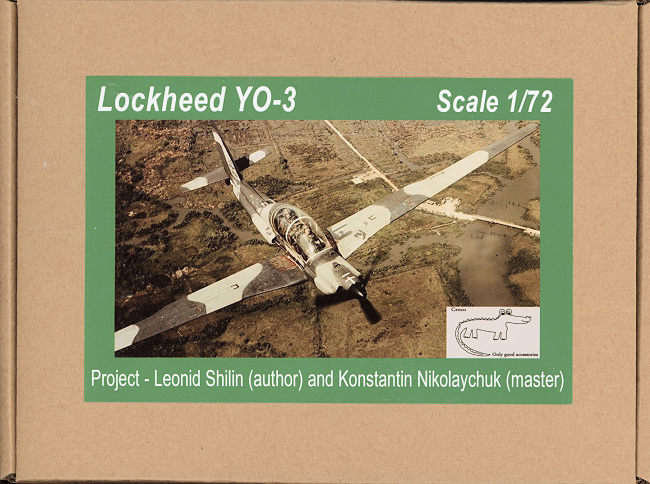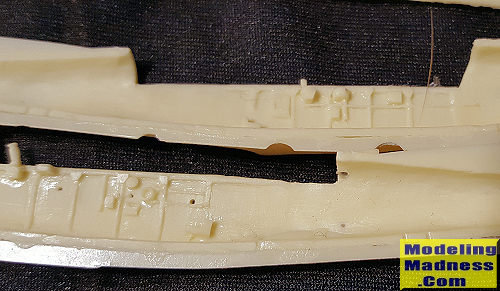
Croco 1/72 Lockheed YO-3A 'Quiet Star'
| KIT #: | |
| PRICE: | € |
| DECALS: | Three options |
| REVIEWER: | Scott Van Aken |
| NOTES: | Resin with vacuformed canopies |

| HISTORY |
The YO-3A was designed to a U.S. Army specification of 1968, which called for an observation aircraft that would be acoustically undetectable from the ground when flying at an altitude of 1,200 feet (355 m) at night.
Lockheed Missiles and Space Company located in Sunnyvale, California was contracted to produce two prototype aircraft. In 1966, the company built two QT-2 "Quiet Thrusters", using modified Schweizer SGS 2-32 gliders. The prototype QT-2s were then modified to the QT-2PC "PRIZE CREW" configuration. The QT-2PC had a silenced engine and a slow turning propeller for quiet operation.
Following operational trials with the QT-2PC in Vietnam, a production aircraft, designated the YO-3A was ordered. This aircraft's design was also based on the Schweizer SGS 2-32 glider. Like the QT-2PC, the YO-3A has a large wingspan and a larger canopy area for observation. Two crew members (a pilot and an observer) are seated in tandem. The observer is located at the front of the cockpit. The YO-3 is an all-metal low-wing monoplane of semi-monocoque construction. The control surfaces of the YO-3 including the ailerons and rudder are fabric covered. The engine cover, canopy, engine exhaust shroud, wing-root fairings, and wheel-well fairings were constructed of fiberglass. The YO-3 has retractable tailwheel-type landing gear.
The YO-3A was powered by an air-cooled, six-cylinder, horizontally opposed, fuel injected, Continental Model No. IO-360D engine. The engine is coupled to a slow turning propeller through a belt pulley-drive system. The propeller reduction ratio is 3.33:1. Originally equipped with a six bladed ground-adjustable-pitch propeller, this was replaced in March 1971 with a three bladed laminated constant speed wooden propeller produced by Ole Fahlin. The engine cowling and firewall were lined with fiberglass material to dampen and contain engine noise.
The YO-3A is equipped with an Asymmetrical Exhaust System. A crossover exhaust pipe is used to remove exhaust from the left bank of engine cylinders to the right side of the engine compartment. This crossover joins the right bank exhaust pipe and exits along the lower right side of the engine compartment. The exhaust gases are then moved through an acoustical fairing into a dissipating and resonating muffler continuing to the aft end of the fuselage.
Nine of the 11 YO-3As produced operated in South Vietnam, at night, from 1970 to 1971 (14 months) and never took a round or were shot down. The YO-3A was very successful in spotting movement by the North Vietnamese, but its deployment late in the American involvement in Vietnam reduced its value in that war. By early 1973 all American troops were out of Vietnam.
| THE KIT |

 The
kit has quite a few fairly small parts, with pretty much all of them fitting in
the cockpit. The 'pit give you a pair of seats, a pair of roll bars behind each
seat, a proper instrument panel for the pilot and the front seat observer and
the pilot's control stick. Croco has put a lot of detail on the sidewalls of the
fuselage halves so you don't have to fuss with really small bits and pieces.
There is no photo etch because you don't need it.
The
kit has quite a few fairly small parts, with pretty much all of them fitting in
the cockpit. The 'pit give you a pair of seats, a pair of roll bars behind each
seat, a proper instrument panel for the pilot and the front seat observer and
the pilot's control stick. Croco has put a lot of detail on the sidewalls of the
fuselage halves so you don't have to fuss with really small bits and pieces.
There is no photo etch because you don't need it.
| CONCLUSIONS |
This is a great subject and you'll probably only see this sort of thing in resin due to so few being built. For experienced short run resin builders, it will provide no challenges. I wouldn't recommend this one for a beginner due to the very fine interior parts, but the rest of us shouldn't have any major issues with it. Just take care and be sure to fully clean up and test fit each part before applying the super glue or epoxy.
| REFERENCES |
June 2019
Thanks to Croco for the preview item. Contact them at sniff23@inbox.lv for information and costs.
If you would like your product reviewed fairly and fairly quickly, please contact the editor or see other details in the Note to Contributors.
Back to the Main Page Back to the Review Index Page Back to the Previews Index Page